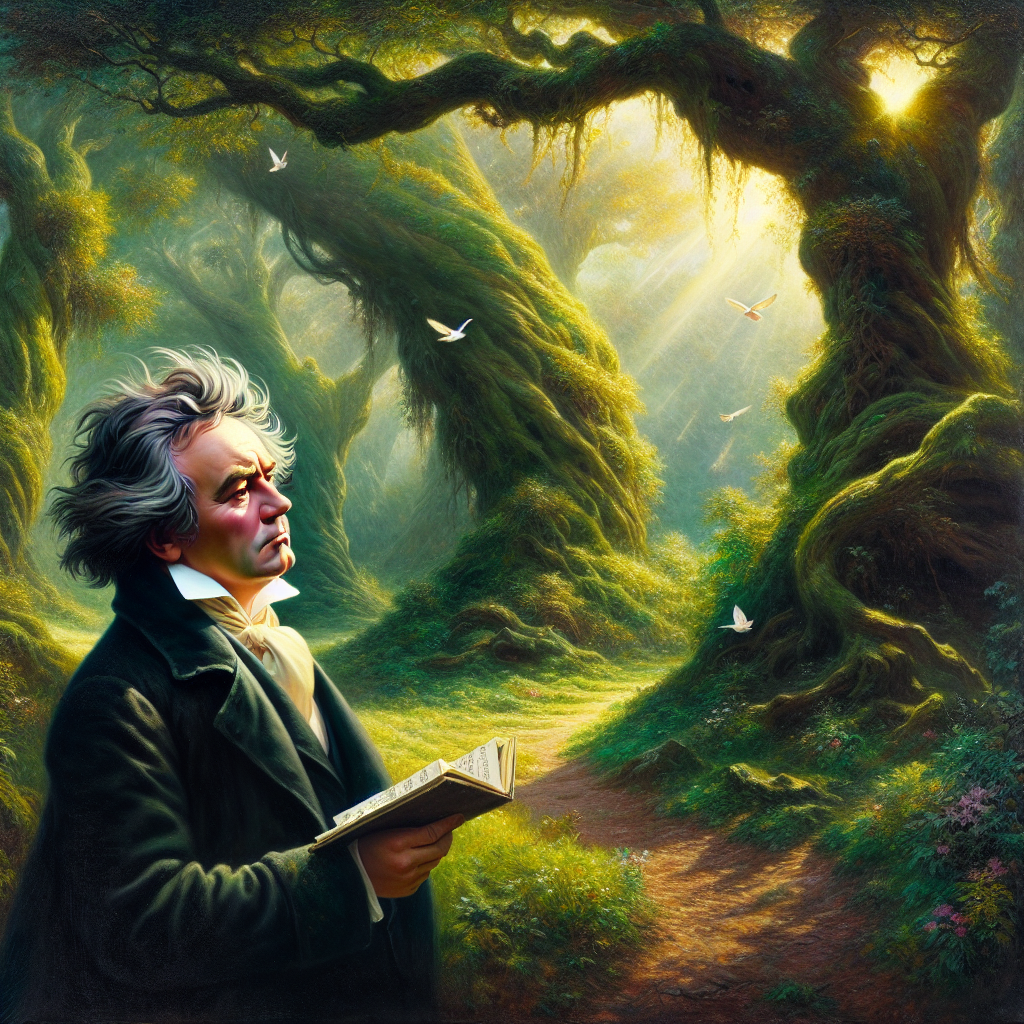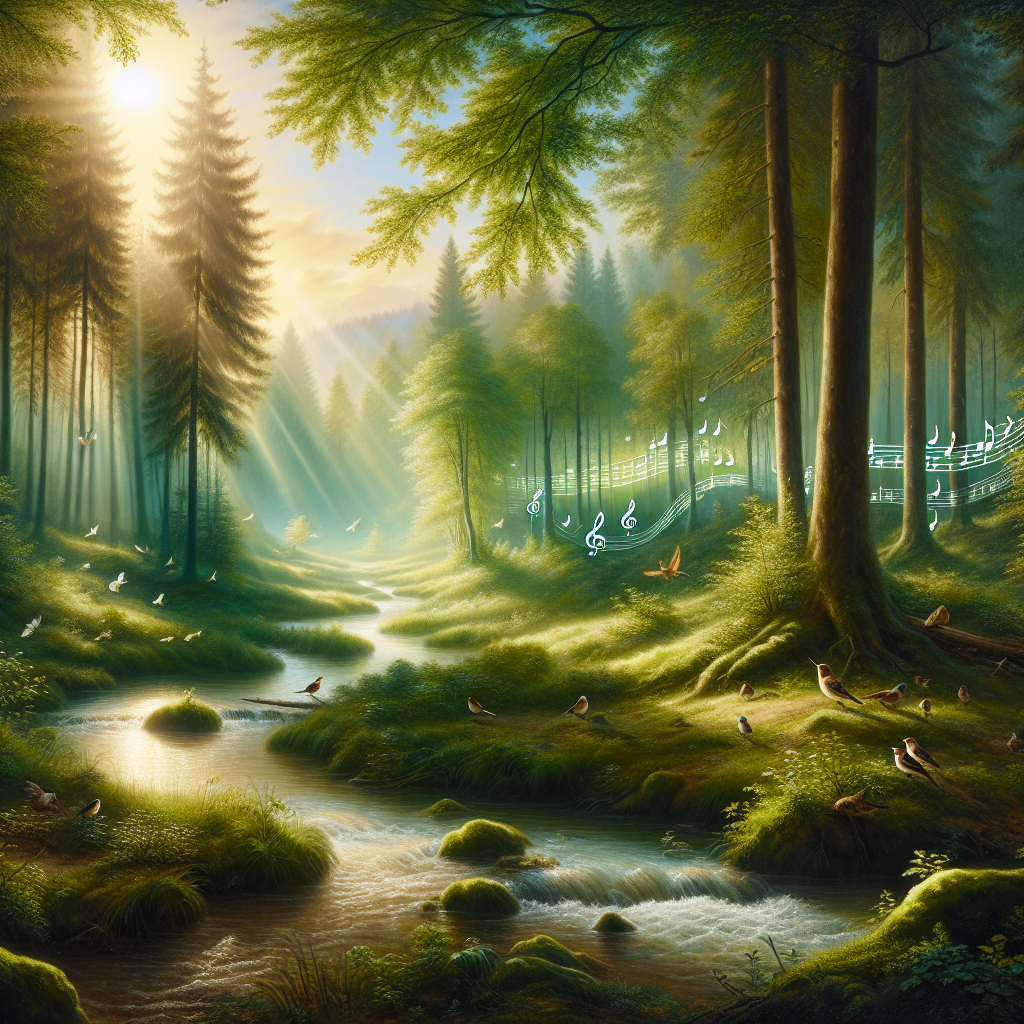
Beethoven’s Love for Nature and Its Influence on His Music
Ludwig van Beethoven, born on December 17, 1770, in Bonn, Germany, is one of the most celebrated and influential composers in the history of Western music. Renowned for his symphonies, sonatas, and concertos, Beethoven’s genius transcended the musical norms of his time, laying the groundwork for future generations of composers. While his life’s narrative often focuses on his prodigious talent and tragic battle with deafness, one vital aspect that is frequently overlooked is his profound love for nature. Beethoven’s bond with the natural world not only provided him with solace and inspiration but also significantly influenced his compositions. In the bucolic landscapes, he found a sanctuary that harmonized with his musical creativity, enabling him to produce some of his most iconic works. This article delves into Beethoven’s affinity for nature, its impact on his music, and how this connection is reflected in his timeless masterpieces.
Beethoven lived during a period marked by significant political and social upheaval. The French Revolution and the Napoleonic Wars reshaped Europe, while the burgeoning Romantic movement began to break away from strict Classical forms to embrace individualism, emotional depth, and a greater appreciation of the natural world. Within this context, Beethoven’s upbringing in the scenic Rhine Valley planted the seeds of his lifelong admiration for nature. His frequent walks in the forests and countryside became a meditative practice, helping him to clear his mind and tap into his creativity. Beethoven’s introspective nature and turbulent personal life further fueled his penchant for retreating into nature, which he regarded as a refuge from the challenges he faced.
This introduction sets the stage for a comprehensive exploration of how Beethoven’s love for nature intertwined with his music. We will examine pivotal moments and compositions influenced by his natural surroundings, analyze the broader influences and contemporaries that shaped his artistry, and consider the lasting impact of his nature-inspired works. By understanding Beethoven’s relationship with the natural world, we gain deeper insight into the man behind the legend and the timeless beauty of his music.
Beethoven’s Early Years and Exposure to Nature:
Beethoven’s early years in Bonn were punctuated by a near-constant exposure to the lush landscapes of the Rhine Valley. As a child, Beethoven was often seen wandering the forests, fields, and riverbanks. This frequent communion with nature provided him not only with a sense of freedom but also with endless sources of inspiration. His family life was troubled—his father was an alcoholic who ruthlessly pushed him to become a musical prodigy. Nature, therefore, became an essential escape from the harsh realities at home.
The landscapes of his youth etched vivid memories that would re-emerge throughout his life. Beethoven’s early compositions reflected the structured, formal styles of the Classical era, but even then, there were hints of a deep-seated connection to the natural world. For instance, his early piano sonatas often contain motifs that mimic bird calls and rustling leaves, foreshadowing his later, more explicit use of nature-inspired themes.
In these formative years, Beethoven was exposed to the works of composers such as Joseph Haydn and Wolfgang Amadeus Mozart. While he admired their mastery, Beethoven sought to break free from their compositional constraints by infusing his music with personal emotion and natural phenomena. His early encounters with nature thus played a foundational role in developing his distinct musical voice, one that would eventually redefine the boundaries of Classical music.
As Beethoven transitioned from Bonn to Vienna, the cultural capital of Europe, he carried with him his experiential and emotional connection to nature. His relationship with the natural world would soon become a profound element of his mature works, evident even as he navigated the bustling urban life and high society of Vienna.
Vienna: An Urban Nexus and Natural Sanctuary:
Vienna in the late 18th and early 19th centuries was a city of contrasts—both a bustling hub of cultural activity and a gateway to the serene Austrian landscapes. Upon moving to Vienna in 1792, Beethoven quickly became part of its illustrious musical scene, studying under Haydn and meeting other contemporaries like Antonio Salieri. Despite the urban environment, Beethoven’s connection to nature remained unwavering, and he often escaped the city to find solitude in the countryside.
In Vienna, Beethoven composed some of his most significant early works, including his first two symphonies. The idyllic surroundings of Heiligenstadt, where he spent his summers, provided a crucial backdrop for these compositions. It was during this time that Beethoven wrote the deeply emotional “Heiligenstadt Testament,” a letter addressed to his brothers where he confesses the despair over his encroaching deafness but also his determination to continue his artistic journey.
The idyllic rural settings around Vienna played a role in shaping Beethoven’s Pastoral Symphony (Symphony No. 6), hailed as one of his most direct tributes to nature. The piece, characterized by its lyrical melodies and programmatic elements, vividly captures the composer’s immersive experience of the natural world. From the joyous rhythms mimicking flowing streams to the evocative “Scene by the Brook,” Beethoven invites listeners into his serene refuge, contrasting sharply with the turmoil of his personal struggles.
Beethoven’s dedication to exploring the symbiotic relationship between music and nature marked a significant departure from his contemporaries, who were often more focused on adhering to formal conventions. His works, imbued with natural elements, not only resonated with the Romantic ideals of individualism and emotional depth but also continued to endear audiences to the beauty and inspiration of the natural world.

Influence of the Natural World on Beethoven’s Symphonies:
Beethoven’s capacity to channel his experiences with nature into his music transcended mere inspiration, affecting the very structure and thematic elements of his symphonies. In addition to the Pastoral Symphony, numerous other works bear testimony to his profound bond with the natural environment. The majestic Symphony No. 3, also known as the Eroica Symphony, reflects Beethoven’s philosophical meditations and heroism, themes he often contemplated during his retreats into nature.
During the composition of his monumental Symphony No. 9, Beethoven’s profound connection to nature reached a spiritual zenith. The “Ode to Joy,” with its universal message of unity and brotherhood, echoes the harmony Beethoven witnessed in nature. Despite his advancing deafness, which by then had rendered him almost completely unable to hear, Beethoven’s music emanated an ethereal quality, suggesting that his mental and emotional alignment with nature facilitated a transcendental creative process.
Moreover, Beethoven’s Symphony No. 8 vividly illustrates his capacity to depict natural phenomena through music. Lighter and more humorous compared to his other symphonies, it includes references to the ticking of a metronome, akin to the rhythmic consistency found in natural cycles. His harmonic innovations and use of motifs not only painted acoustic pictures of nature but also pushed the boundaries of symphonic structure and expression.
Beethoven’s symphonies created a rich tapestry that intertwined the human experience with the natural world, reflecting both his inner emotional landscape and the external environments that nurtured his creativity. This fusion of nature and music culminated in a body of work that remains unparalleled in its depth and resonance.
Beethoven’s Contemporaries and Their Views on Nature:
Beethoven was not isolated in his reverence for nature; many of his contemporaries and predecessors, including the likes of Goethe and Schiller, shared similar sentiments. The Romantic era was characterized by an idealization of nature, reflecting a broader societal shift towards a deeper appreciation of the natural world as a source of emotional and spiritual fulfillment.
Johann Wolfgang von Goethe, for instance, was a significant figure in the Romantic movement whose literary works often explored humanity’s connection with nature. Beethoven’s admiration for Goethe’s poetry is well-documented, with many of Beethoven’s vocal and choral works drawing inspiration from Goethe’s texts. The symbiosis between Beethoven’s musical interpretations and Goethe’s lyrical explorations illustrated a unified Romantic ethos, emphasizing nature as a vital force in artistic creation.
Similarly, Friedrich Schiller’s “Ode to Joy,” the text for the final movement of Beethoven’s Ninth Symphony, encapsulated the Romantic ideal of harmony between mankind and the natural world. Beethoven’s ability to amplify Schiller’s message through his powerful musical composition underscored his deep-seated belief in the interdependence of human joy and nature.
In contrast, many classical composers like Haydn and Mozart, while appreciative of the natural world, often integrated these elements within more rigid compositional frameworks. Beethoven’s approach was far more fluid and intuitive, merging form and thematic content in ways that were pioneering for his time. His nature-influenced works were both reflective and revolutionary, setting the stage for the broader Romantic movement to embrace the natural world as an essential muse.
Beethoven’s Legacy and Nature-inspired Works:
Beethoven’s genius lay not only in his technical prowess but also in his ability to convey profound emotions and universal truths through his music. His nature-inspired works reflect this remarkable talent, leaving a lasting legacy that continues to resonate with audiences and musicians alike.
Perhaps no single work better encapsulates Beethoven’s devotion to nature than his Pastoral Symphony. Each movement, from the bucolic “Awakening of Cheerful Feelings on Arrival in the Countryside” to the tempestuous “Thunderstorm,” carries listeners through an immersive auditory journey, evoking the beauty and dynamism of the natural world. Such vivid portrayals served to deepen the emotional impact of his music, creating timeless connections with audiences.
Furthermore, Beethoven’s legacy extends beyond his symphonies. His late string quartets, particularly Op. 132, reflect his introspective contemplation of life, spirituality, and the natural world. The “Heiliger Dankgesang” (Holy Song of Thanksgiving), written after recovering from a severe illness, embodies the composer’s gratitude and reverence for life’s natural cycles, channeling his personal experiences into a transcendent musical expression.
As subsequent generations of composers and artists explored the Romantic ideal of nature, Beethoven’s influence became increasingly apparent. Composers like Franz Schubert, Robert Schumann, and Johannes Brahms drew upon Beethoven’s nature-inspired frameworks to create their own enduring masterpieces. Beethoven’s ability to blend natural imagery with profound human emotion set a precedent that would shape the course of Western music for centuries.
Conclusion:
In exploring Beethoven’s love for nature and its influence on his music, we unearth a deeper understanding of the composer’s extraordinary legacy. From his early years in the Rhine Valley to his mature compositions in Vienna, Beethoven’s bond with the natural world was a constant, guiding force in his creative journey. His works, deeply infused with natural elements, not only reflect his personal experiences but also convey universal themes of harmony, resilience, and transcendence.
Beethoven’s nature-inspired music stands as a testament to the power of the natural world to nurture and inspire human creativity. His ability to translate the beauty and complexity of nature into sound forged a timeless connection with audiences, inviting them into his world of auditory splendor.
Through his symphonies, sonatas, and choral works, Beethoven crafted an enduring legacy that continues to captivate and inspire. His profound appreciation for nature, woven seamlessly into his music, offers a lasting reminder of the intrinsic bond between art and the natural world.
As we reflect on Beethoven’s life and music, it becomes evident that his love for nature was not merely a backdrop to his creativity but a vital, integral force that shaped his artistic vision. In embracing the natural world, Beethoven found the freedom to express the depths of his soul, leaving a legacy that resonates as powerfully today as it did in his own time.